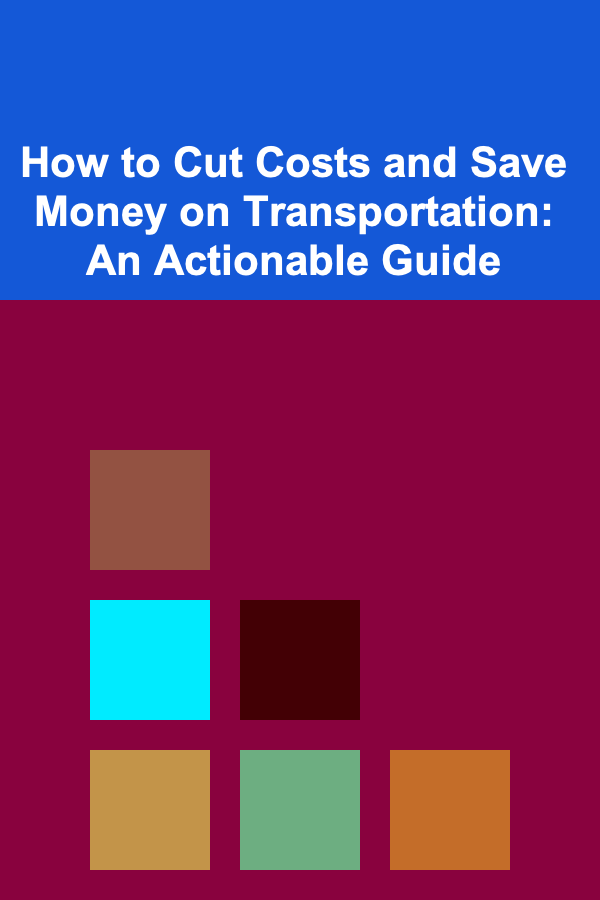
How to Cut Costs and Save Money on Transportation: An Actionable Guide
ebook include PDF & Audio bundle (Micro Guide)
$12.99$10.99
Limited Time Offer! Order within the next:

Transportation expenses can make up a significant portion of your budget, whether you're commuting for work, running errands, or planning a road trip. However, there are many ways to reduce transportation costs without sacrificing convenience or safety. This guide will walk you through actionable strategies to save money on transportation, focusing on different modes of travel, tips for efficient use of resources, and long-term savings.
Optimize Your Vehicle Usage
A. Maintain Your Vehicle Regularly
Proper maintenance is crucial to ensuring that your vehicle runs efficiently, thereby reducing costs in the long run.
- Regular oil changes: Changing your oil as recommended by your vehicle manufacturer helps maintain engine performance and efficiency, preventing costly repairs later on.
- Tire maintenance: Proper tire inflation can reduce fuel consumption by up to 3%. Check tire pressure regularly and replace worn-out tires to avoid poor fuel economy.
- Engine tuning: A well-maintained engine can improve fuel efficiency and overall vehicle performance. Ensure your engine runs at its optimal level with regular tune-ups.
- Air filter replacements: Replacing clogged air filters can improve fuel economy by up to 10%, especially in older cars.
B. Improve Fuel Efficiency
Maximizing fuel efficiency is one of the quickest ways to cut transportation costs. Here are some tips:
- Drive smoothly: Avoid sudden starts and stops. Accelerate gradually and maintain a consistent speed to maximize fuel efficiency.
- Use cruise control: On highways, cruise control can help you maintain a steady speed, saving fuel and reducing wear on the engine.
- Minimize idling: Idling for long periods can waste fuel. If you're stopped for more than 30 seconds (except in traffic), it's often better to turn off the engine and restart when you're ready to go.
C. Carpool or Rideshare
Carpooling or using rideshare services like Uber or Lyft can significantly reduce the cost per trip, especially when commuting to work or traveling with others.
- Share your ride: If you have a colleague or neighbor with a similar commute, consider sharing the ride to reduce the overall cost of fuel and vehicle wear and tear.
- Use ridesharing apps: If carpooling with others is not an option, consider using ridesharing apps, which allow you to share rides with others traveling in the same direction, thus splitting the cost.
- Plan your routes: Plan your trips efficiently to avoid detours or unnecessary stops, ensuring that you're getting the most out of each ride.
D. Reduce Your Vehicle's Weight
The more weight your vehicle carries, the harder it has to work, which can reduce fuel efficiency. Consider:
- Remove unnecessary items: Clear out any unnecessary items in your car to reduce weight. For example, excess baggage or equipment that you don't need for daily use.
- Use roof racks wisely: If you use a roof rack or carrier, be mindful of the added drag. Use it only when necessary, as it can negatively impact fuel efficiency.
Embrace Public Transportation
Using public transportation is one of the most effective ways to cut costs, especially for urban dwellers who don't need to drive every day. Here's how to get the most out of public transit:
A. Use Monthly or Annual Passes
Most cities offer discounted passes for frequent commuters, which can reduce the overall cost of transportation.
- Monthly or annual transit passes: These are typically more affordable than paying for individual fares. If you use public transit regularly, these passes can offer significant savings.
- Student or senior discounts: Many public transit systems provide discounts for students, seniors, or people with disabilities. Check if you qualify for any of these.
B. Plan Your Routes Efficiently
To make public transit as affordable as possible, plan your routes carefully:
- Avoid peak hours: During peak hours, public transit can be overcrowded and inefficient. If possible, try to travel during off-peak hours when fares may also be lower, and the experience is more pleasant.
- Use real-time tracking apps: Most public transit systems now offer apps with real-time tracking. These can help you avoid long waits and find the fastest routes.
C. Consider Alternative Modes of Public Transit
Public transportation doesn't have to be limited to buses and trains. Look for alternatives that might offer more flexibility:
- Bike-sharing: Many cities now have bike-sharing programs. If your destination is within a reasonable distance, biking can be a great way to save money and improve your health.
- Car-sharing services: Companies like Zipcar or Turo offer a way to rent a car for a short period, often cheaper than traditional car rental services. This is useful if you need a car for just a few hours or a day.
- Scooter rentals: In urban areas, electric scooters have become a popular mode of transportation. They're inexpensive for short trips and can be a fun, eco-friendly option.
Adopt Alternative Travel Methods
If public transportation isn't an option or doesn't fit your needs, consider alternative modes of travel that can save money over time.
A. Biking
Biking is an excellent low-cost alternative for short to medium-distance travel. Aside from the initial cost of purchasing a bike, maintenance costs are low, and you'll save on gas and parking fees.
- Invest in a good bike: A well-maintained bike can last for years, making it a cost-effective choice for daily commuting.
- Choose safe routes: Research bike lanes or bike-friendly routes in your city to avoid dangerous traffic.
B. Walking
For very short distances, walking can be the most cost-effective and healthiest option.
- Stay fit: Walking is free and good for your health. It's perfect for trips to local stores, meetings, or recreational outings within your neighborhood.
- Combine with other transportation: For longer trips, walk to a transit station or park-and-ride lot to avoid driving for the entire distance.
Consider Flexible Work Arrangements
Commuting costs can add up, especially if you're driving to work every day. If your job allows it, consider these alternatives:
A. Work from Home
Remote work can drastically reduce your transportation costs. If your employer offers telecommuting options, taking advantage of this can save you money on gas, parking, and public transit fares.
B. Flexible Hours
If you can't work from home, consider asking your employer for flexible hours. By adjusting your work schedule to avoid peak traffic times, you can reduce your commute time and transportation costs.
C. Ride-Sharing for Work
If you have colleagues who live nearby, consider organizing a ride-sharing schedule for the office. This can help you save on gas and parking fees while also reducing the wear and tear on your vehicle.
Find the Best Fuel Prices
Gas prices fluctuate depending on location, time of day, and market conditions. By being mindful of when and where you buy fuel, you can save money.
- Use gas price apps: Apps like GasBuddy can help you find the lowest prices in your area. Plan your fuel stops around the most affordable stations.
- Join loyalty programs: Many gas stations offer rewards programs that can save you money per gallon or offer discounts on future purchases.
- Fuel up early in the day: Gas prices tend to rise later in the day, so fueling up in the morning may save you a few cents per gallon.
Reevaluate Your Need for a Car
Finally, ask yourself if you really need a car at all. In some situations, owning a car may not be the most cost-effective option.
- Consider car-free living: In densely populated urban areas, it might make more sense to rely on public transit, biking, walking, and ridesharing rather than owning a car. This eliminates costs like car payments, insurance, maintenance, and parking fees.
- Use car subscription services: Some companies offer car subscription services that let you pay a monthly fee for a car without the commitment of ownership. This can be an affordable option for people who don't need a car every day.
Conclusion
Transportation costs can add up quickly, but with a little planning and mindful decision-making, it's possible to save money while still getting where you need to go. Whether it's optimizing your vehicle, using public transportation, embracing alternative travel methods, or adjusting your work arrangements, there are many ways to cut costs. By taking action on these strategies, you can reduce your transportation expenses and put that money toward other important financial goals.

How to Balance Your Full-Time Job with Part-Time Writing Projects
Read More
How to Create a Checklist for Choosing the Perfect Venue for Your Fundraising Event
Read More
How to Declutter and Clean Your Home Before a Move
Read More
How to Make Money Online as a Speech Therapist: 10 Actionable Ideas
Read More
How to Sell Digital Products Successfully for Photographers & Videographers
Read More
How to Share Your Kitchen Organization Tips on Social Media
Read MoreOther Products

How to Balance Your Full-Time Job with Part-Time Writing Projects
Read More
How to Create a Checklist for Choosing the Perfect Venue for Your Fundraising Event
Read More
How to Declutter and Clean Your Home Before a Move
Read More
How to Make Money Online as a Speech Therapist: 10 Actionable Ideas
Read More
How to Sell Digital Products Successfully for Photographers & Videographers
Read More